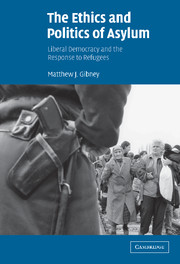Book contents
- Frontmatter
- Contents
- Acknowledgements
- Introduction
- 1 Partiality: community, citizenship and the defence of closure
- 2 Impartiality: freedom, equality and open borders
- 3 The Federal Republic of Germany: the rise and fall of a right to asylum
- 4 The United Kingdom: the value of asylum
- 5 The United States: the making and breaking of a refugee consensus
- 6 Australia: restricting asylum, resettling refugees
- 7 From ideal to non-ideal theory: reckoning with the state, politics and consequences
- 8 Liberal democratic states and ethically defensible asylum practices
- List of references
- Index
5 - The United States: the making and breaking of a refugee consensus
Published online by Cambridge University Press: 22 September 2009
- Frontmatter
- Contents
- Acknowledgements
- Introduction
- 1 Partiality: community, citizenship and the defence of closure
- 2 Impartiality: freedom, equality and open borders
- 3 The Federal Republic of Germany: the rise and fall of a right to asylum
- 4 The United Kingdom: the value of asylum
- 5 The United States: the making and breaking of a refugee consensus
- 6 Australia: restricting asylum, resettling refugees
- 7 From ideal to non-ideal theory: reckoning with the state, politics and consequences
- 8 Liberal democratic states and ethically defensible asylum practices
- List of references
- Index
Summary
No Western country has accepted more refugees since the end of World War II than the United States (Holman 1996). Between 1946 and 1994 the US allowed almost 3 million refugees and other foreigners seeking protection access to permanent residence. While this remarkable inclusiveness has sometimes been attributed to a peculiarly American sensitivity to immigrants in need, less partial observers have seen it as evidence of the way refugee admissions have become entangled with foreign policy. As Kathleen Newland noted, refugee policy in the US has long been a ‘handmaiden of foreign policy’. The belief that it would ‘contribute to the overarching objective of damaging and ultimately defeating Communist countries, particularly the Soviet Union’ (Newland 1995: 190) encouraged an openness that, at times during the Cold War, reached breathtaking heights. In 1965, President Lyndon Johnson issued an open invitation to Cubans discontented with Fidel Castro's rule to head for the US. Standing in front of the Statue of Liberty, he declared that all Cubans ‘seeking refuge here in America will find it’ (quoted in Masud-Polito) 1988: 57).
Throughout much of the post-war period this inclusiveness has had a less admirable flip side: callous disregard for and even hostility to refugees fleeing right-wing dictatorships and other non-communist regimes. While all Western countries gave special preference to refugees from communist countries during the Cold War, no country knit together its definition of a refugee with escape from communism as tightly as the US.
- Type
- Chapter
- Information
- The Ethics and Politics of AsylumLiberal Democracy and the Response to Refugees, pp. 132 - 165Publisher: Cambridge University PressPrint publication year: 2004
- 1
- Cited by



